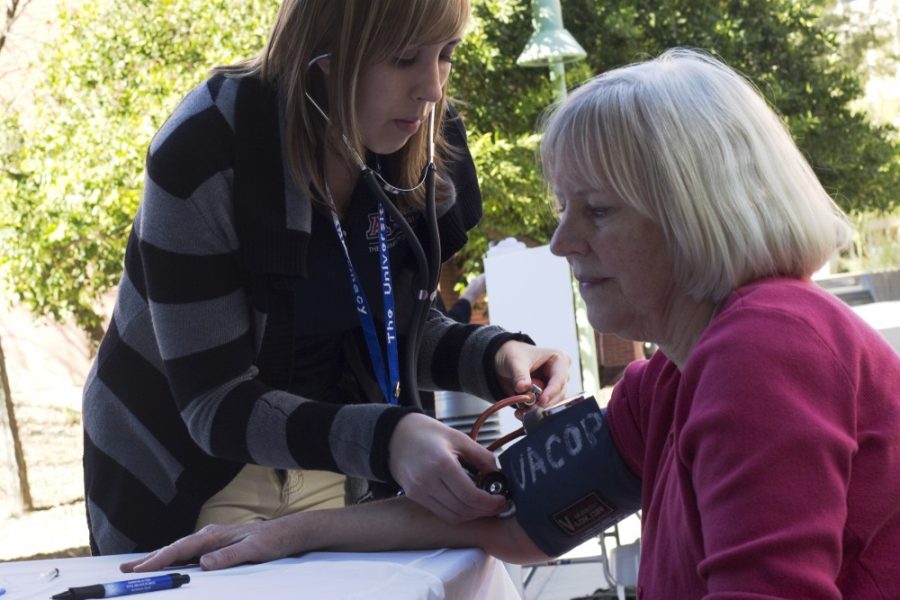Fair presents preventative care practices, resources
Lydia Stern / Arizona Daily Wildcat Kayla Ward, first-year pharmacy student, checks the blood pressure of Anne Sunderland at the Health and Wellness Forum. Various health organizations gather at the forum each year to focus on educating the community about health.
March 5, 2012
Health care policies and lifesaving techniques were discussed and demonstrated at the Arizona Health Forum and Health and Wellness Fair on Saturday.
The fair, hosted by the Arizona Health Sciences Center, brought together UA health care leaders and local organizations to discuss health care issues as well as offer free health screenings and CPR demonstrations.
The focus on preventative care was a main issue in the health care debate. Doctors, professors, and insurance directors explained that preventative care is both important and costly, and that patients in Arizona need quality treatment.
“We do not have a health care system, but one of fragmented care,” said Dr. Keith Joiner, co-director of the Center for Management Innovations in Health Care at the Eller College of Management. Health care reform needs to stress coordination between health care providers, patients and those involved in helping to prevent bad health, he said.
Various organizations had booths at the fair. Using resources from the UA Sarver Heart Center, students from the College of Medicine and College of Pharmacy demonstrated how to use an automatic external defibrillator. These devices are portable and can automatically diagnose certain life-threatening cardiac arrhythmias, and can treat the arrhythmias through electrical therapy.
These defibrillators can cost anywhere from $1,000 to $1,500, according to Saman Nematollahi, a second-year medical student.
As part of the demonstration, Mitchell Bartlett, a second-year medical student, placed small pads from the device on a mannequin’s chest and gave a series of shocks to the mannequin alternated by chest compressions. The demonstration was also part of a citywide initiative mandated by Tucson Mayor Jonathan Rothschild to promote safety, and included an effort to train 500,000 people in life-saving techniques, according to Katie Maass, director of communications at Sarver Heart Center.
In addition to teaching individuals how to use a defibrillator, the fair featured asthma, blood pressure, glucose and glaucoma screenings. Medical students held most of the screenings and were moderated by professors from the College of Medicine.
Certified ophthalmologists also held glaucoma screenings for individuals who were considered to be high risk, which included people with a family history of glaucoma and those age 50 or older. The screenings looked for eye conditions that could lead to damage in the optic nerve. Although high-risk patients need to be screened, anyone can be at risk for glaucoma, according to Jon LaMee, a second-year medical student.
Medical students also tested attendees’ blood pressure and glucose levels, as well as their lung capacity. After the basic screenings, people were either given a sheet that said their screenings turned out clean, or were given a referral to check up with a doctor.
“That is why these screenings are so important,” said Amy Nguyen, a first-year pharmacy student.
The fair was not just about preventing physical ailments. Jesus Acuña, a UA alumnus and wellness support specialist for CODAC Behavioral Health Services, stressed the importance of behavioral health in addition to physical health. People need to be taught physical education, nutrition information and be offered relationship and general counseling, he said.



